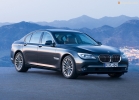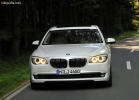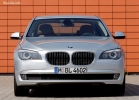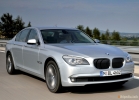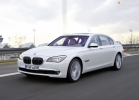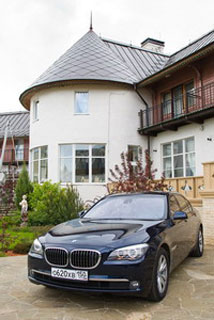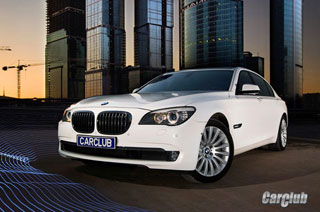Test drive BMW 7 series F01 02 since 2008 sedan
Formula 760
The Autoban asphalt looks like a smeared gray ribbon, the information system projects a circle crossed by three stripes on the windshield (not? NOT? NIMITIONS), and numbers 240. On the right, like roadside columns, various representatives of golf class flicker at a speed of 150 km/h/h. . The engine singing merges with a quiet melody coming from speakers, and a huge sedan goes, no, flies, smoothly and? Stable ... It is for such shots along the highways (well, for prestige, naturally) manufacturers and equip the representatives of the representative class with the most powerful engines . Six liters of working volume, 12 cylinders, eight programs - this is the formula of the new BMW 760LI.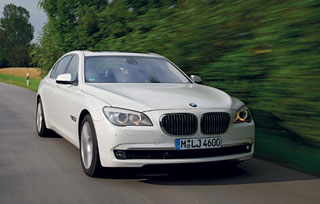
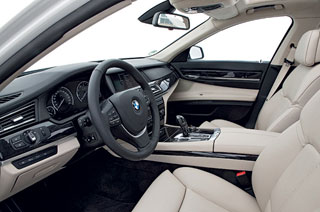
Honestly, in the BMW 760LI cabin, I was conquered by the tank panel and not inlaid inserts made of walnut wood, which was not even covered with leather, but a system for projection of information on the windshield and verified ergonomics.
Sales of the fifth generation of the BMW of the seventh series began nine months ago, so that the appearance of the new car has already become familiar. But in Munich, I was brought by the presentation by the Bavarian concern of his flagship versions, cars with 760i and 760LI indices. The number 6, located between the seven and zero, indicates that the machines have been equipped with engines with a working volume of 6 liters, and in accordance with the traditions of the company for 20 years now, the most powerful BMW engines have have been configuration V12. In fact, the history of the Bavarian V12 began in? The 20s of the last century. In 1926, BMW engineers developed their first 12-cylinder aviation engine with a volume of 46 liters. By the way, not everyone knows that in? 1930, the mass licensed release of this motor was deployed in the USSR, where he received the M-17 index. Both Chelyuskintsev were saved, and the expedition of Papanin to the North Pole landed the aircraft on which these engines stood. In addition, the fastest (BT-5 and BT-7) and the most difficult (T-28 and T-35) tanks of the Red Army set in motion the same M-17. But then there was a second world, and for many years a 12-cylinder theme was closed. They returned to? She only in 1987, when a 750i sedan appeared in the gamut of BMW cars. Later, the volume of the flagship engine increased to 6 liters, and since then, models with an index of 760 traditionally crown a line of cars of the company, constantly adding in power.
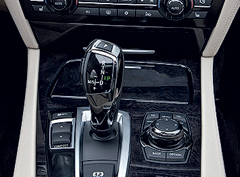
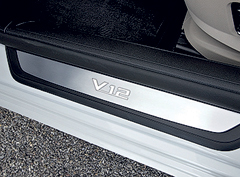
In terms of interior design, the 760th differs from the younger versions with the use of such high-tech material as ceramics (an automatic transmission selector, and a IDRive control handle can be made from it), as well as polished overlays with a luminous inscription ZV12I.
For the new F01/F02 chassis, Bavarian designers did not violate traditions. The power of the motor increased by as much as 22% - from 439 to 544 hp, torque - by 25% - from 600 to 750 nm, and the acceleration time to a hundred decreased from 5.5 to 4.9 s. A naive person could have imagined that the appetite of the novelty would also grow, but we are not one of them and we know: all firms have been boasting for ten years now that, increasing the power of their engines, they simultaneously manage to reduce the consumption of fuel. So the BMW 760i, according to passport data with a mixed motion cycle, spends only 12.9 liters of fuel per 100 km, which is 5% less than the BMW 760 in the E65 body.
But perhaps the efforts of some motorist for such results would not be enough. A new eight -speed automatic transmission, developed jointly with ZF, plays a significant role here. The unit is very compact, and eight steps and five multidimensional friction fruits provide exceptional smoothness of the gear shifts and the accurate correspondence of the selected transmission by the speed mode. Well, to evaluate how all this luxury behaves on the go, we were able to on a 400-kilometer route from the company's headquarters to the castle of Hohenkammer and back.
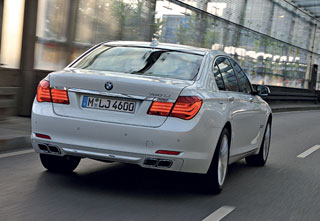
Outside, the BMW 760 is easiest to distinguish from other seeds by dodging exhaust pipes. And thank God that the designers made the back of the car visually a little easier!
The 760th 760th seeds can be distinguished by the nameplate on the trunk lid, the v12 nameplate is near the turning indicator and the double exhaust pipes. There is also a difference in internal arrangement: this is the instrument panel, covered with leather NAPPA with a stitching, and? The ceiling, sheathed by alcantara, and decorative inserts from the root of walnut wood with inlay, and steel overlays on the thresholds with a luminous inscription V12. Plus, for the first time used in the design of the car, ceramics, from which the IDRive controller, a faceted handle of an electronic gear jacket, rotary climate control regulators and audio systems can be made.
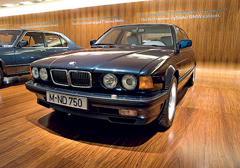
There are many such BMW 750i (in the E32 back) still running along the roads of the world. The same car rightfully took its place in the BMW Museum, because it was with it that in 1987 the history of the flagships of the Bavarian concern equipped with V12 engines began.
From the predecessor both the interior and the appearance of the body of the F02 are most serious. As for the appearance, it clearly has become more sports. But in order to understand what exactly influenced the choice of design solutions, you need to take the driver's seat and get out of the city crowd to the high -speed highway. That's when you click on the accelerator pedal to the kik dowl, when a dull victorious growl of a dozen fiery devils comes from under the hood, when acceleration presses you into a leather seat, then an understanding of why the design of the front of the flagship has more stylistic resemblance to the Z4 component (E86 body) and M6 (E64) than with the previous top model.
The previous chassis with the factory index E65 was scolded for the lack of sports severity in management, but this time the pendulum of design thought swayed in the other direction: in the front row of the new 760LI seats, all the bumps and joints in the asphalt are felt more than clearly. The back row passengers feel somewhat less, but you still do not have the illusions of the air pillow. And this despite the pneumatic suspension of the integral V-shaped aluminum rear axle, designed specifically for the new seventh series. But how much drive on winding suburban tracks! This is where the capabilities of the active suspension Dynamic Drive and the Dynamic Damping Control system are fully implemented.
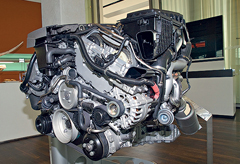
The new V12 engine with two turbochargers (TwinPower Turbo technology), the High Precision Injection direct injection system and the Doppel-Vanos gas distribution system extracts a 6.0-liter working volume of 544 hp. And at the same time, it complies with Euro-5 toxicity.
In general, take an engine with two turbochargers and a direct injection system, which at your disposal has huge power and torque at idle. Add the automatic transmission, thanks to which the car definitely goes behind the pedal, and, by transferring the selector to manual mode, you can instantly select the right gear, add the constantly audible voice of the motor (I suspect that acoustics intentionally did not dull it), the steering wheel that can be rotated with one finger With maneuvers in the parking lot, but pouring with a pleasant weight at speed. Complete the equation of the optional, steering rear suspension and highly effective brakes - and you will have a very accurate image of the BMW 760i and 760LI, representative cars with makings of the racing car. Probably, not everyone will appeal to such a balance of qualities, but it will be all the more interesting to reduce the flagship seven in a full-time duel with an eternal competitor-Mercedes-Benz S600 with its 510-horsepower V12 Biturbo.
Mercedes-Benz S 400 Hybrid
Engine: V6 3.5 L + electric motor
Power, L.S.: 279+20
Moment, nm: 350+160
Transmission: A7
Maximum speed: 250 * km /h * limited by electronics
Acceleration 0100 km /h, s: 7.9
Fuel consumption per 100 km: 7.98.1 liters
Equipped mass, kg: 1955
Extrication CO2, g/km: 186189
Price in Moscow: 3 880 800 rubles.
Text: Andrey Fatebin
Photo: Andrey Fatebin, BMW
A source: "Autopilot"

